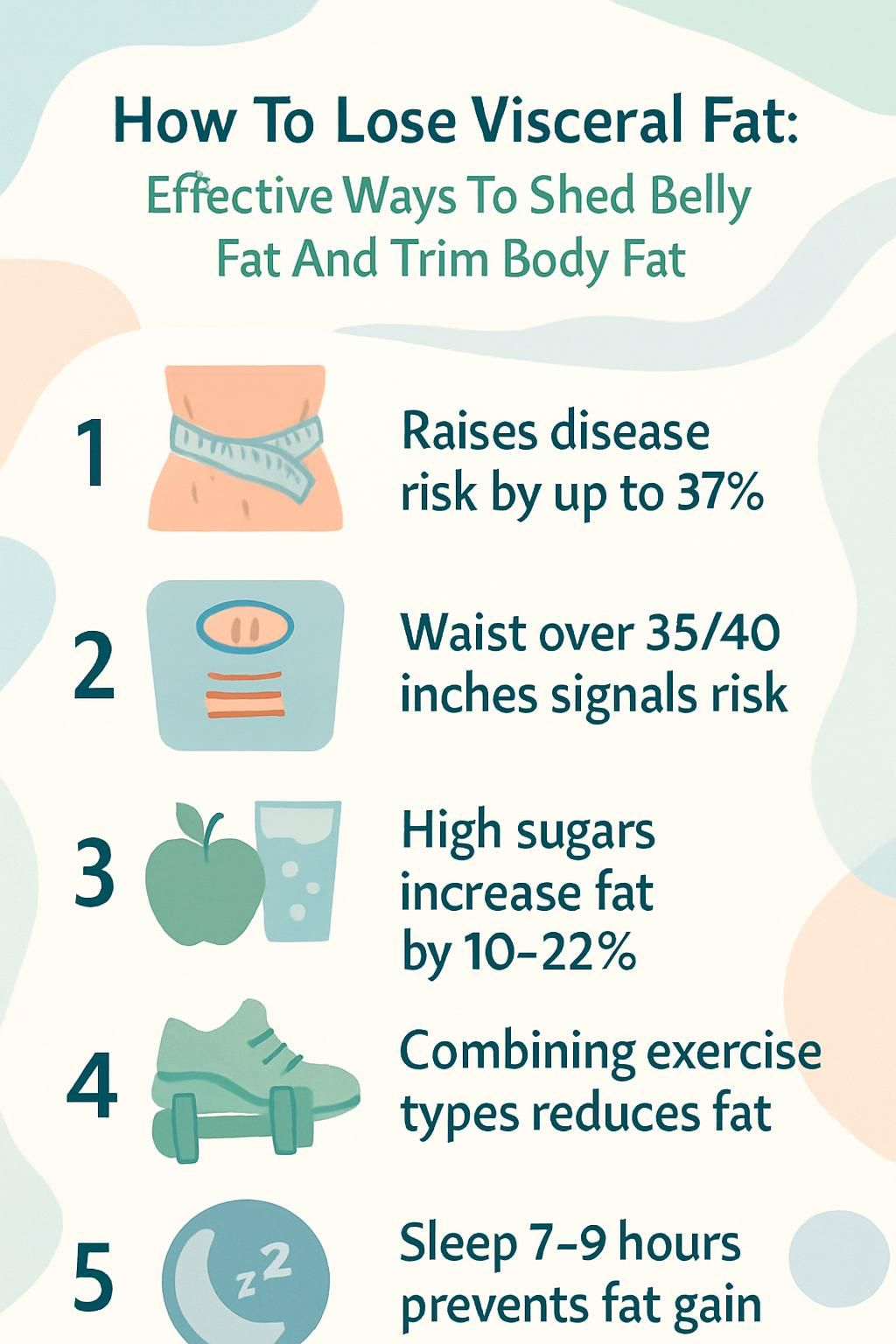How To Lose Visceral Fat: Effective Ways To Shed Belly Fat And Trim Body Fat
Our Nutrition Assistant AI Suite will transform your body. You will lose fat, get toned, and build muscle. Gain confidence and optimal health.
If you want to lose visceral fat and trim stubborn belly fat, you are not alone. Visceral fat sits deep in your abdomen and presses on organs such as the liver and heart. Too much of this hidden fat raises the risk of type 2 diabetes and heart disease.
This guide shows how to reduce visceral fat with simple, science-based steps. You will learn how to eat well, move more, track your waist with a tape measure, and build steady habits. Small changes can lead to lower body fat, a smaller waistline, and better health.
Key Takeaways
- Visceral fat surrounds internal organs and increases the risk of heart disease, type 2 diabetes, metabolic syndrome, asthma, and some cancers. Public health groups, including the CDC, warn that higher amounts raise disease risk.
- A waist size above 35 inches for women or 40 inches for men signals excess visceral fat and greater risk, even if body mass index looks normal.
- Diets high in added sugars, fructose above 50 grams per day, and ultra-processed foods boost organ fat. Mediterranean and DASH eating patterns are linked with lower visceral fat.
- Combining regular aerobic exercise, strength training twice a week, and high intensity intervals reduces visceral fat more effectively than doing spot moves alone.
- Managing stress, getting 7 to 9 hours of sleep, limiting alcohol, and quitting smoking help prevent belly fat gain and reduce disease risk.

What Is Visceral Fat and Where Is It Located?

Visceral fat is hidden fat that collects deep inside your abdomen. It wraps around organs such as the liver, stomach, and intestines. Unlike subcutaneous fat under the skin, you cannot see it, but it carries higher health risks.
What is visceral fat and how does it differ from other fat types?
Visceral fat lies behind your abdominal muscles and surrounds critical organs, including the liver, kidneys, and intestines. It is more active than subcutaneous fat, which sits under the skin, because it releases hormones and inflammatory chemicals into the blood.
Roughly 10 percent of your total body fat is visceral. The remaining 90 percent is subcutaneous, the kind you can pinch at the waist or hips. The hidden nature of visceral fat makes it easy to miss, yet it raises risk more than the fat you can see.
This fat behaves like a hormone factory. It can increase cortisol, a stress hormone, and worsen insulin resistance. Higher visceral adipose tissue raises the chance of cardiovascular disease and metabolic syndrome.
I once measured a waist over 40 inches. After adding brisk walks and cutting sweets and refined grains, my waist dropped and my energy rose within weeks.
“Visceral fat isn’t just an issue on the scale; it’s a signal from your body that deeper changes are needed for better health.”
Next, see where this abdominal fat sits inside the body.
Where is visceral fat found in the body?
Visceral fat lives deep in the abdominal cavity. It surrounds organs such as the liver, pancreas, heart, and kidneys. Because it sits beneath the abdominal wall, it cannot be pinched like the fat on the hips or thighs.
The omentum, a fatty apron inside the abdomen, often stores this fat. During menopause, many women notice more belly fat around the waistline because hormones shift with age.
Waist sizes above 35 inches for women and 40 inches for men usually signal more intra-abdominal fat, raising the risk of obesity-related problems like high blood pressure, cardiovascular disease, and diabetes. Doctors use CT scans or MRI to measure visceral fat accurately since routine exams cannot see it well.
How is visceral fat different from subcutaneous fat?
Visceral fat sits close to organs and makes more inflammatory chemicals called cytokines. Subcutaneous fat rests under the skin and makes up most of your total body fat. You can pinch subcutaneous fat, but not visceral fat.
Because visceral fat is more active, it is linked with higher risk of heart disease, type 2 diabetes, and high blood pressure. Liposuction removes subcutaneous fat only. It does not target the deeper visceral stores that drive health risk.
Up next, learn about the health risks that come with too much visceral fat.
What Are the Health Risks of Excess Visceral Fat?
Excess visceral fat raises the chance of chronic disease and metabolic problems. Taking action now can reduce risk and support long-term health.
What medical complications are linked to high visceral fat?
High visceral fat increases risk of cardiovascular disease, type 2 diabetes, and unhealthy cholesterol patterns. People with the highest levels face more atherosclerosis and other circulation issues.
Increased belly fat is also linked with high blood pressure, fatty liver disease, sleep apnea, and some cancers, including colorectal adenomas. In one large sample of women, a waist over 35 inches was tied to a higher rate of asthma.
Hormone disorders such as Cushing syndrome and hypothyroidism may relate to higher visceral fat. Greater abdominal fat also links with higher risk of early death.
Several years ago, my doctor measured my waist during a routine visit and found abdominal obesity, even though my frame looked thin. With diet changes and regular exercise, my blood pressure and cholesterol improved within months.
How does visceral fat contribute to chronic diseases?
Visceral fat sends out cytokines that trigger constant low-level inflammation. That inflammation raises the risk of heart disease, type 2 diabetes, and other chronic conditions.
This fat also releases chemicals that tighten blood vessels. Tighter vessels can increase blood pressure. More visceral fat is tied to higher blood sugar, higher triglycerides, and lower HDL cholesterol, which together form metabolic syndrome.
In one European study, women ages 45 to 79 with larger waists had roughly double the risk of heart disease compared to those with smaller waists. Kaiser Permanente research found that adults with more visceral fat in their forties were far more likely to face dementia later in life.
Asthma risk rises too, likely due to inflammation that affects the airways. Every two inches of added waist size raises the risk of cardiovascular disease by about ten percent.
How does visceral fat affect metabolism?
Fat cells deep in the abdomen respond quickly to hormones, including cortisol from stress. With a healthy diet and regular exercise, visceral fat can decline faster than the fat under your skin.
High visceral fat releases hormones and cytokines that disrupt normal metabolism. These changes can lead to insulin resistance, a key driver of type 2 diabetes and some cancers.
Insulin resistance also increases the chance of metabolic syndrome, which includes problems with blood sugar, cholesterol, and blood pressure. A larger waist to hip or waist to height ratio signals higher risk for these issues.
After I added daily walking and basic strength training, my energy improved and cravings fell. That waist drop reflected better metabolic health, not just fewer pounds.
Understanding what causes visceral fat helps you take control sooner.
Key Factors That Cause Visceral Fat Gain
Food choices, low physical activity, genetics, and hormones all shape where your body stores fat. Knowing these drivers makes change feel more possible.
How does diet influence visceral fat accumulation?
Diets high in added sugar and unhealthy fats push your body to store more belly fat. Fructose in sweetened drinks is a frequent trigger for visceral fat buildup.
Large portions and a steady flow of ultra-processed foods raise calories quickly. Extra energy tends to be stored as visceral fat. Regular drinking also adds empty calories and burdens the liver. Many men benefit from staying under two drinks per day.
Mediterranean and DASH eating patterns focus on whole grains, lean proteins, nuts, vegetables, and healthy fatty acids. These choices support a healthy weight and help reduce organ fat over time.
Tracking intake for a week can reveal habits that push fat gain. I swapped soda for water and packed lunches. My waist dropped nearly two inches in three months.
Summary Table
| Dietary Factor | Impact on Visceral Fat |
|---|---|
| Sugary drinks | Increases accumulation |
| Ultra-processed foods | Raises storage |
| Large portions | Adds excess calories |
| High fructose intake | Promotes belly storage |
| Alcohol | Contributes to belly gain |
| Whole grains and protein | Help reduce levels |
Balanced meals make it easier to manage blood pressure, blood sugar, and long-term risk.
What role does physical activity play in fat buildup?
Sitting most of the day slows metabolism and encourages fat storage, especially around the liver and intestines. Regular movement, such as walking, taking stairs, or standing during calls, helps curb visceral fat buildup.
The American Heart Association suggests at least 150 minutes of moderate exercise per week. Both aerobic workouts and strength training matter. High intensity interval training, or HIIT, often produces greater belly fat loss than steady cardio alone.
Spot exercises tone muscles but do not target fat in one area. After I added brisk walks plus two strength sessions each week, my waist size dropped on repeat checks.
Exercise also helps prevent weight regain by supporting your metabolic rate as you age.
How do genetics and hormones impact body fat levels?
Your genes influence where you store fat and how much visceral fat you may carry. Hormones play a major role. Chronic stress raises cortisol, which promotes belly fat storage.
After menopause, many women notice more fat around the waist due to hormone changes. A slow loss of muscle with age makes weight gain easier. Many men in their fifties need fewer daily calories than in their thirties to avoid gaining fat.
My parents both gained more belly fat after 50, even with solid habits. Genetics can tilt the odds, yet consistent routines still help.
How Can You Measure Visceral Fat Levels?
Several tools help you estimate visceral fat. They guide your plan and track progress over time.
How do you measure waist circumference accurately?
Stand tall and place a flexible tape measure just above your hip bone at the navel. Keep the tape snug, not tight. Relax and exhale, then record the number. Make sure the tape is level and not twisted.
A waist size of 35 inches or more in women, or 40 inches or more in men, signals higher visceral fat and added health risk. Measure monthly to spot trends. Waist to hip ratio above 0.85 for women or 0.90 for men signals higher risk.
Your waist should be less than half your height to lower risk. How your pants fit can also reveal changes.
I check my waist at home and log the number. Small, steady drops keep me motivated when the scale barely moves.
What does BMI tell us about fat distribution?
Waist size measures belly fat more directly, but BMI still helps screen for weight-related risk. A BMI of 30 or higher flags obesity and a greater chance of excess visceral fat.
That said, BMI does not separate muscle, bone, and fat types. Someone with a normal BMI can still have high visceral fat if the waist is large. Waist to height ratio is often a clearer risk signal than BMI alone.
Clinicians use BMI with other tests before judging risk for stroke or heart disease linked to visceral adipose tissue. Athletes may show a high BMI due to muscle, not extra fat.
What imaging methods are used to analyze visceral fat?
CT and MRI give the most accurate visceral fat measurements. They show fat layers around organs and can separate subcutaneous from intra-abdominal fat. MRI does not use radiation and still provides reliable detail.
These scans cost more, so they are used mainly in research or when needed for clinical care.
In a fitness study, researchers used MRI to track my belly fat after twelve weeks of intervals. The before and after pictures made progress clear and motivating.
Imaging also helps study how diets like the Mediterranean pattern change body composition. Next is how to track risk when scans are not available.
Effective Strategies to Reduce Visceral Fat
Evidence-based strategies work best for lasting results. The steps below help you lose belly fat and improve physical fitness.
What dietary changes help with fat loss?
Creating a modest calorie deficit is the best way to lose fat. Fill your plate with fruits, vegetables, nuts, beans, and whole grains for fiber and nutrients. These foods help you feel full with fewer calories.
Choose lean proteins, such as fish, poultry, tofu, or beans, to protect muscle while losing weight. Use olive oil in place of saturated fats. Replace sugary drinks with water, coffee, or tea without added sugar.
Share restaurant entrees or use smaller plates to manage portions. Limit ultra-processed foods, which seem to push fat gain and harm blood vessels. Mediterranean and DASH diets provide a balanced path and support steady visceral fat loss.
Tracking intake or meeting with a clinician can help you stay on course.
Why should processed foods and sugars be limited?
Processed foods and added sugars often pack extra calories with few nutrients. Sodas and packaged snacks contain simple sugars such as fructose that raise visceral fat over time.
These foods do little to curb hunger, which makes a calorie deficit harder. High intake of ultra-processed foods is linked with insulin resistance in fat cells, a pattern tied to belly fat storage and higher disease risk.
Cutting back improves appetite control and metabolic health. During college, I reduced frozen meals and cookies. My core felt tighter and workouts felt easier.
Data Table: Sugar Intake and Visceral Fat
| Factor | Effect |
|---|---|
| Sugary drinks | Higher waist size in population studies |
| Ultra-processed foods | Greater insulin resistance risk |
| Added sugar above 50 g per day | More organ fat buildup |
Limiting these foods supports weight loss and better body composition.
How do whole grains, proteins, and vegetables aid fat loss?
Whole grains bring fiber that helps you feel full, which supports lower calorie intake and smaller waists. Vegetables deliver nutrients and antioxidants for very few calories, making weight control easier.
Lean proteins protect skeletal muscle while losing fat, and they slow digestion to cut hunger. These foods help control blood sugar and insulin spikes, which influence how and where your body stores fat.
Experts often recommend these choices as part of Mediterranean or DASH diets for steady, sustainable fat loss.
What are the benefits of the Mediterranean and DASH diets?
Both plans center on fruits, vegetables, whole grains, legumes, nuts, and healthy fats like olive oil. Red meat, processed foods, and added sugars are limited. These patterns reduce inflammation, improve cholesterol, and help control blood pressure.
Studies link these diets with lower visceral fat and better organ health. A clinician or dietitian can tailor meal plans to your needs and health goals.
Most people also notice better blood sugar control and improved tissue function when they follow these proven eating styles.
What types of exercise help reduce visceral fat?
Use both aerobic exercise and strength training to reduce visceral fat. Aim for at least 150 minutes of moderate aerobic activity each week, such as brisk walking, cycling, swimming, or jogging.
Add high intensity intervals for greater fat loss in less time. Short bursts of hard effort raise your calorie burn during and after a workout.
Strength training at least twice a week builds muscle and raises resting metabolism. Lift weights, use resistance bands, or do bodyweight moves like squats and lunges.
Regular movement through the day, such as walking and taking stairs, supports your fat loss plan.
How do cardiovascular workouts burn fat effectively?
Brisk walking, running, cycling, and swimming lift your heart rate and increase calorie burn. Doing at least 30 minutes, five days per week, helps your body use stored energy and lower total and visceral fat.
Aerobic training improves insulin sensitivity and often trims the waist more than being inactive. It also lowers triglycerides and raises HDL cholesterol, both good for the heart.
I saw steady changes after several weeks of consistent running. My belly shrank even when the scale stalled.
Consistency with cardio brings gradual, healthy fat loss. It is a core part of any plan to reduce visceral fat and strengthen metabolic health.
What are the benefits of strength training?
Strength work builds and maintains muscle, which raises your metabolism and helps you burn calories at rest. At least two sessions each week protect muscle while you lose weight.
Recent studies show resistance training reduces both visceral and subcutaneous fat. Keeping muscle is vital because losing muscle slows metabolism.
Over time, strength routines also fight age-related muscle loss. Combining weights or resistance bands with aerobic training gives the best results.
After adding two lifting sessions per week, my waist shrank even when my body weight barely changed. More energy and a firmer shape followed.
How does HIIT improve fat loss results?
HIIT uses short bursts of intense effort followed by recovery. This style often beats steady exercise for visceral fat loss, based on multiple reviews of clinical trials.
You can do HIIT with cardio, weights, or bodyweight moves. These sessions increase heart rate fast and improve fitness. HIIT also boosts insulin sensitivity, which helps your body use energy instead of storing it.
Even 20-minute HIIT sessions helped shrink my waist and cut body fat. Many people find it time-efficient and effective.
What lifestyle changes support fat management?
Lasting fat loss depends on daily habits. Aim for 7 to 9 hours of sleep to restore tissues and balance appetite hormones. Lowering stress helps reduce cortisol, which can drive belly fat storage.
Limit alcohol to support liver health and avoid empty calories. Quitting smoking improves metabolism and reduces health risks tied to abdominal fat.
Simple steps, such as daily walks and stretch breaks, raise calorie burn. Tracking waist size or weekly progress keeps you focused.
Intermittent fasting may help some people reduce visceral fat, according to recent studies. Keep your meal, movement, and sleep schedule as consistent as possible.
How can stress management techniques reduce fat?
Chronic stress raises cortisol, which prompts your body to store more visceral fat. Practices such as yoga, meditation, or slow breathing lower stress and improve appetite control.
People who use mindfulness often report fewer cravings for sugary or fatty snacks. During a demanding school term, I added brief relaxation each evening. My sleep improved, cravings faded, and my weight trended down.
Better stress control balances hormones and supports steady fat loss. Quality sleep also improves when stress falls, which further helps appetite and energy use.
Why is adequate sleep important for fat loss?
Adults under 40 who sleep 5 hours or less tend to gain more visceral fat than those who get enough sleep. Sleeping more than 8 hours may also raise belly fat in younger adults, so aim for 7 to 9 hours.
Poor sleep disrupts appetite hormones and leads to cravings for sugary or processed foods. Good sleep improves workout recovery and day-long energy, which supports steady calorie burn.
I built a regular bedtime and stopped late-night snacking. Progress sped up and my waistline changed faster.
Healthy sleep habits work hand in hand with stress control to support fat loss around the organs.
How do reducing alcohol and quitting smoking help?
Alcohol brings empty calories and can increase belly fat. Drinking more than two servings per day raises the risk of visceral fat buildup, especially in men. Cutting back helps reset hormones and supports better fat distribution.
Smoking disrupts metabolism and raises the chance of storing more abdominal fat. Quitting lowers the risk of metabolic syndrome and chronic diseases such as heart disease and diabetes.
After trimming weekend drinks and skipping stress cigarettes at work, my pants felt looser within weeks. People who drop both habits often see a faster fall in stubborn belly fat.
Additional Approaches for Losing Visceral Fat
Tracking and steady routines keep you moving forward. These methods help you notice changes even when the scale is slow.
How can tracking body measurements help monitor progress?
Use a tape measure at the navel after you exhale. Log the number each time you measure. Women above 35 inches and men above 40 inches face higher risk from excess visceral fat.
Keep notes on waist to hip and waist to height ratios for a fuller picture. If your pants fit differently, your body is changing.
I logged my waist every two weeks. Even when my weight stalled, my waist dropped by an inch in a month. That feedback helped me adjust meals and training to keep losing belly fat.
Why is consistency important in health routines?
Consistent habits drive real change within 2 to 3 months. A steady exercise schedule, such as 30 minutes five days per week, lowers visceral fat that sits around organs like the liver and intestines.
Sticking to healthy eating plans, including the Mediterranean diet with its monounsaturated fat from olive oil and nuts, improves the odds of success.
Daily stress care lowers cortisol, which slows fat buildup. Quality sleep supports appetite and metabolism. Tracking waist size over time shows trends better than one measurement.
Gradual loss from steady habits outperforms quick fixes every time.
When should you consult healthcare professionals?
Talk with a clinician if you have high blood pressure, diabetes, or a strong family history of chronic disease. They can assess your health and guide safe weight loss.
If diet and exercise are not reducing visceral fat, ask for help. Doctors may run tests for organ health or use imaging to estimate deeper fat stores.
You might need a personal plan. Professionals can recommend Mediterranean or DASH eating and design a program with cardio and strength training that fits your life.
A doctor once flagged issues in my bloodwork. Their guidance reshaped my routine and led to better results. Regular check-ins can catch problems early and lower risk linked to visceral fat.
Health information in this article is educational and not a substitute for medical advice. See your healthcare provider for personal guidance.
What Are Common Misconceptions About Losing Visceral Fat?
Many people expect crunches to melt belly fat. Real fat loss depends on your whole routine, not one move.
Why is spot reduction ineffective?
Spot reduction does not work because fat loss occurs across the entire body. Crunches and other ab moves strengthen muscles, but they do not pull fat only from the belly.
Fat loss comes from a calorie deficit created with diet and activity. Your body uses energy from all fat stores, including the visceral fat deep in the abdomen.
Clients who chased only ab exercises saw little change. Once they used full body training and improved meals, their waistlines finally moved.
Experts agree that pairing cardio with strength training is the most effective way to reduce visceral fat and improve health.
What are the drawbacks of quick fixes and fad diets?
Quick fixes promise rapid losses, but they rarely reduce visceral fat for long. Many extreme plans cut whole food groups and lead to nutrient gaps. Stress also rises with strict rules, and cortisol can push belly fat storage.
Skipping meals or using severe limits may drop pounds fast, but they return quickly. Your metabolism can slow, and eating patterns become harder to manage.
I tried a trendy diet and lost five pounds fast, then felt weak and irritable. The plan did not fit daily life, so the weight came back. Real progress comes from balanced meals, regular exercise, and stress and sleep care.
What Are the Benefits of Losing Visceral Fat?
Less visceral fat supports higher energy and better fitness. It can also lift your mood and improve daily life.
How does losing visceral fat reduce disease risks?
Lower visceral fat reduces the risk of heart disease, stroke, type 2 diabetes, and certain cancers. This hidden fat surrounds organs and raises blood pressure and cholesterol, which strain the heart and liver.
Keeping your waist under half your height is a simple way to protect your organs. As visceral fat falls, blood sugar control improves and the body handles fats better.
Steady changes such as eating more whole grains, nuts, and vegetables, and drinking less alcohol, make a lasting difference.
How does fat loss increase energy and fitness?
Reducing visceral fat helps your body use energy more efficiently. Regular exercise and a balanced diet build stronger muscles and a healthier metabolism, which boosts daily energy.
Better sleep and smart stress care reduce fatigue and support better workouts. Many people find intermittent fasting helpful, especially when paired with whole foods and training.
Tracking your waist shows real progress even when the scale is slow to move.
How does losing visceral fat improve quality of life?
As visceral fat drops, blood pressure and lipid profiles often improve. People report better sleep, fewer apnea symptoms, and more daytime energy. Many also feel greater confidence as body composition changes.
Consistent exercise, smarter food choices, and less added sugar support a steady routine. Cutting back on alcohol and quitting smoking often speed results.
Step by step, these habits protect your organs and build a healthier life.
Conclusion
You can shed visceral fat with steady habits and clear priorities. Focus on regular exercise, a healthy diet with lean protein, whole grains, and plenty of vegetables, and track your waist with a tape measure.
Manage stress, aim for 7 to 9 hours of sleep, and limit alcohol. Consistency matters most. As belly fat falls, disease risk declines and energy rises.
These changes protect your organs and support a healthier, more confident you.
FAQs
1. What is visceral fat and why isn’t this fat good for your health?
Visceral fat is a type of body fat stored around internal organs such as the liver and heart. This fat isn’t good because it raises the risk of heart disease, type 2 diabetes, and other health problems. Research shows that excess fat around organs can disrupt normal organ function and increase inflammation in the body (Harvard Health Publishing, 2021).
2. How does stress affect belly fat and overall body fat?
Stress, as a biological response, can increase levels of cortisol, a hormone that signals the body to store more fat, especially around the abdomen. Chronic stress may also lead to unhealthy eating habits, which can cause more fat to build up around organs. Studies link high stress to increased visceral fat (Mayo Clinic, 2022).
3. Which foods help reduce belly fat and support healthy body weight?
Eating more fruits, such as nuts, and vegetables can help reduce belly fat. Nuts, which are rich in healthy fats and protein, support weight loss by making you feel full. Limiting alcohol, which is a drug that adds empty calories, also helps. A balanced diet with fewer processed foods and more whole foods supports fat loss (American Heart Association, 2020).
4. What exercises are effective for losing visceral fat?
Regular physical activity helps burn calories and reduce body fat. Crunches target abdominal muscles but do not remove visceral fat alone. Combining aerobic exercise with strength training is most effective. Losing one pound of mass per week is a safe goal according to the Centers for Disease Control and Prevention.
Summary: Visceral fat surrounds organs and is harmful to health. Stress increases belly fat through hormonal changes. Eating nuts and reducing alcohol intake helps manage body weight. Exercise routines that combine aerobic activity with strength training support safe and steady fat loss. Personal experience shows that tracking food choices and exercise routines leads to better results over time.







